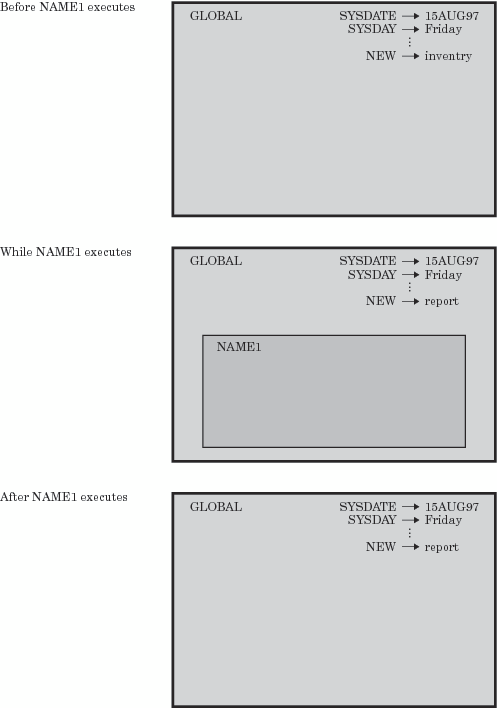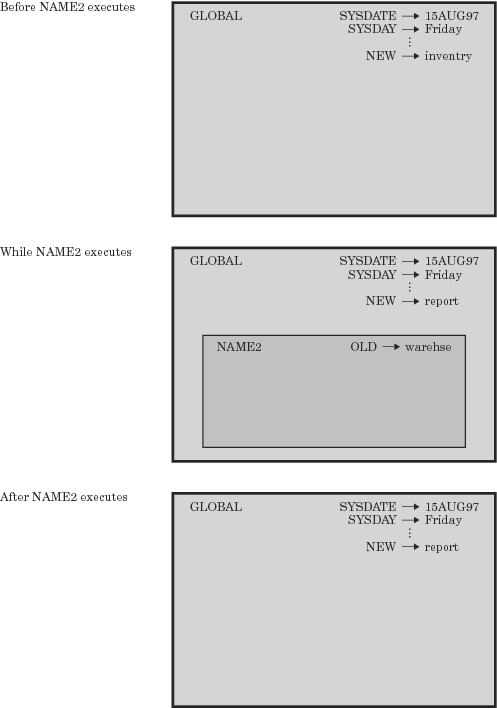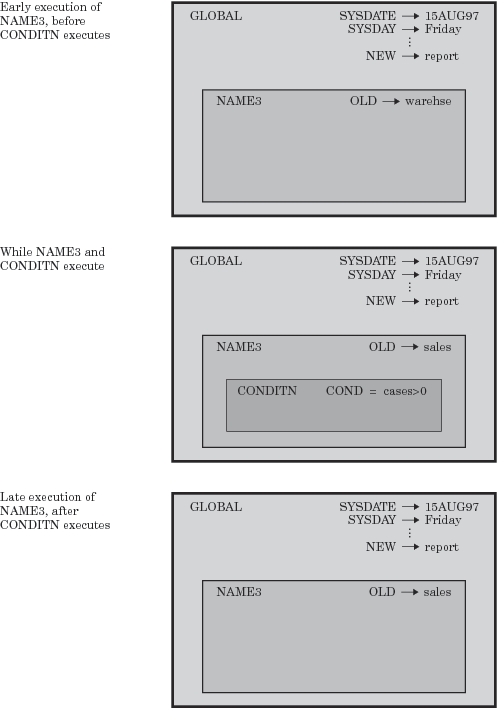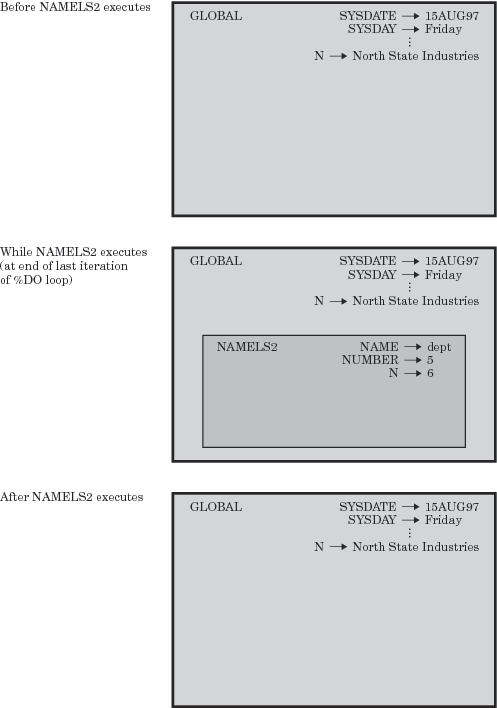Examples of Macro Variable Scopes
Changing the Values of Existing Macro Variables
When
the macro processor executes a macro program statement that can create
a macro variable (such as a %LET statement), the macro processor attempts
to change the value of an existing macro variable rather than create
a new macro variable. The %GLOBAL and %LOCAL statements are exceptions.
To illustrate, consider
the following %LET statements. Both statements assign values to the
macro variable NEW:
Because NEW exists as
a global variable, the macro processor changes the value of the variable
rather than creating a new one. The macro NAME1's local symbol table
remains empty.
Creating Local Variables
When the macro processor executes
a macro program statement that can create a macro variable, the macro
processor creates the variable in the local symbol table if no macro
variable with the same name is available to it. Consider the following
example:
%let new=inventry; %macro name2; %let new=report; %let old=warehse; %mend name2; %name2 data &new; set &old; run;
The macro processor
encounters the reference &OLD after macro NAME2 has finished executing.
Thus, the macro variable OLD no longer exists. The macro processor
is not able to resolve the reference and issues a warning message.
The following figure
illustrates the contents of the global and local symbol tables at
various stages.
%let new=inventry;
%macro name2;
%let new=report;
%let old=warehse;
data &new;
set &old;
run;
%mend name2;
%name2In this case, the macro
processor generates the SET statement during the execution of NAME2,
and it locates OLD in NAME2's local symbol table. Therefore, executing
the macro produces the following statements:
The same rule applies
regardless of how many levels of nesting exist. Consider the following
example:
%let new=inventry;
%macro conditn;
%let old=sales;
%let cond=cases>0;
%mend conditn;
%macro name3;
%let new=report;
%let old=warehse;
%conditn
data &new;
set &old;
if &cond;
run;
%mend name3;
%name3CONDITN finishes executing
before the macro processor reaches the reference &COND, so no
variable named COND exists when the macro processor attempts to resolve
the reference. Thus, the macro processor issues a warning message
and generates the unresolved reference as part of the constant text
and issues a warning message. The following figure shows the symbol
tables at each step.
Forcing a Macro Variable to Be Local
At times that you need to ensure that the macro processor
creates a local macro variable rather than changing the value of an
existing macro variable. In this case, use the %LOCAL statement to
create the macro variable.
Always make all macro
variables created within macros local when you do not need their values
after the macro stops executing. Debugging the large macro programs
is easier if you minimize the possibility of inadvertently changing
a macro variable's value. Also, local macro variables do not exist
after their defining macro finishes executing, while global variables
exist for the duration of the SAS session. Therefore, local variables
use less overall storage.
Suppose you want to
use the macro NAMELST to create a list of names for a VAR statement,
as shown here:
%let n=North State Industries; proc print; var %namelst(dept,5); title "Quarterly Report for &n"; run;
The macro processor
changes the value of the global variable N each time it executes the
iterative %DO loop. (After the loop stops executing, the value of
N is 6, as described in %DO Statement.) To prevent conflicts, use a %LOCAL
statement to create a local variable N, as shown here:
%let n=North State Industries; proc print; var %namels2(dept,5); title "Quarterly Report for &n"; run;
proc print; var dept1 dept2 dept3 dept4 dept5; title "Quarterly Report for North State Industries"; run;
Creating Global Macro Variables
The %GLOBAL statement creates a
global macro variable if a variable with the same name does not already
exist there, regardless of what scope is current.
For example, in the
following program, the macro CONDITN contains a %GLOBAL statement
that creates the macro variable COND as a global variable:
%let new=inventry;
%macro name4;
%let new=report;
%let old=warehse;
%conditn
data &new;
set &old;
if &cond;
run;
%mend name4;
%name4Suppose you want to
put the SAS DATA step statements outside NAME4. In this case, all
the macro variables must be global for the macro processor to resolve
the references. You cannot add OLD to the %GLOBAL statement in CONDITN
because the %LET statement in NAME4 has already created OLD as a local
variable to NAME4 by the time CONDITN begins to execute. (You cannot
use the %GLOBAL statement to make an existing local variable global.)
Thus, to make OLD global,
use the %GLOBAL statement before the variable reference appears anywhere
else, as shown here in the macro NAME5:
%let new=inventry;
%macro conditn;
%global cond;
%let old=sales;
%let cond=cases>0;
%mend conditn;
%macro name5;
%global old;
%let new=report;
%let old=warehse;
%conditn
%mend name5;
%name5
data &new;
set &old;
if &cond;
run;Creating Global Variables Based on the Value of Local Variables
To use a local variable
such as a parameter outside a macro, use a %LET statement to assign
the value to a global variable with a different name, as in this program:
%macro namels3(name,number);
%local n;
%global g_number;
%let g_number=&number;
%do n=1 %to &number;
&name&n
%end;
%mend namels3;


